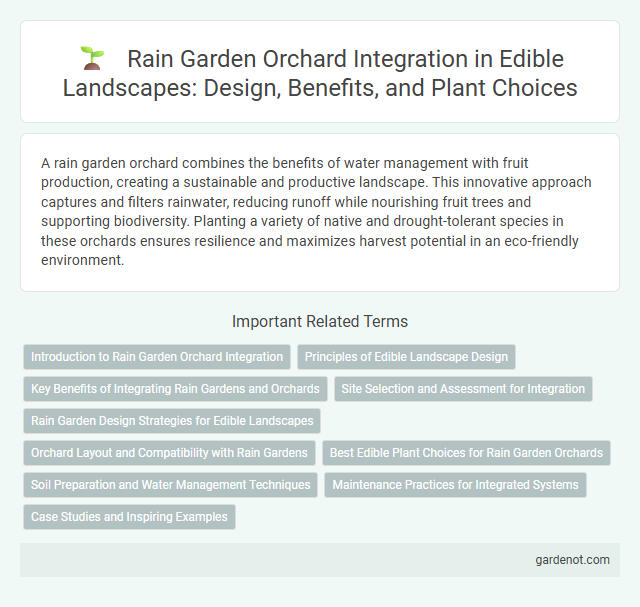A rain garden orchard combines the benefits of water management with fruit production, creating a sustainable and productive landscape. This innovative approach captures and filters rainwater, reducing runoff while nourishing fruit trees and supporting biodiversity. Planting a variety of native and drought-tolerant species in these orchards ensures resilience and maximizes harvest potential in an eco-friendly environment.
Introduction to Rain Garden Orchard Integration
Rain garden orchard integration combines fruit-bearing trees with rain gardens to enhance water management and soil health in sustainable agriculture. This method captures and filters runoff, reducing erosion and promoting groundwater recharge while supporting diverse plant species that thrive in variable moisture conditions. By merging edible landscapes with ecological design, rain garden orchards optimize productivity and environmental benefits on residential and commercial properties.
Principles of Edible Landscape Design
Rain garden orchards integrate sustainable water management with productive fruit tree planting by harnessing natural rainfall and runoff to nourish the soil and plants. Key principles of edible landscape design in this context include selecting drought-tolerant, native fruit varieties, optimizing soil permeability for efficient water absorption, and incorporating diverse plant layers to enhance biodiversity and resilience. Strategic berm and swale construction ensures effective water capture, preventing erosion while supporting healthy root development and maximizing fruit yield.
Key Benefits of Integrating Rain Gardens and Orchards
Integrating rain gardens with orchards enhances water management by naturally filtering stormwater runoff and reducing soil erosion, which improves tree health and fruit yield. This sustainable design boosts biodiversity by creating habitats for pollinators and beneficial insects essential for orchard productivity. Combining these systems also conserves water, lowers irrigation demands, and supports nutrient cycling, making the edible landscape more resilient and eco-friendly.
Site Selection and Assessment for Integration
Rain garden orchards require careful site selection prioritizing areas with moderate to high natural drainage and sunlight exposure between 6 to 8 hours daily. Soil assessment must focus on permeability and nutrient content to ensure water absorption and root development, preferring loam or sandy loam textures. Integrating rain gardens within orchard layouts optimizes stormwater management, reduces erosion, and enhances fruit tree health through improved moisture regulation.
Rain Garden Design Strategies for Edible Landscapes
Rain garden orchard design integrates stormwater management with productive fruit-bearing trees to enhance both ecology and yield. Key strategies include selecting deep-rooted, drought-tolerant species and positioning basins to capture runoff from impervious surfaces, maximizing water infiltration and nutrient retention. Incorporating permeable soils and mulch layers improves soil health while reducing erosion, creating a sustainable edible landscape that supports diverse microhabitats.
Orchard Layout and Compatibility with Rain Gardens
A rain garden orchard integrates fruit trees with strategically designed rain gardens to enhance water absorption and reduce runoff. Orchard layouts prioritize spacing and tree species compatibility to maximize root access to moisture while supporting biodiversity. Selecting drought-tolerant, native fruit varieties ensures effective coexistence with rain gardens, promoting sustainable water management and healthy orchard growth.
Best Edible Plant Choices for Rain Garden Orchards
Rain garden orchards thrive with moisture-loving edible plants such as elderberries, pawpaws, and serviceberries, which tolerate periodic flooding and improve soil health. Native plants like sweetflag and goldenrod also support pollinators while providing edible berries and rhizomes. Selecting deep-rooted species like hazelnuts enhances water absorption and stabilizes the rain garden ecosystem.
Soil Preparation and Water Management Techniques
Rain garden orchards thrive with well-prepared soil that enhances drainage and nutrient retention, featuring layers of organic compost, mulch, and native loam to support root health. Water management techniques such as contouring, swales, and permeable surfaces direct runoff into the orchard, reducing erosion and maximizing water infiltration. Incorporating drought-tolerant rootstocks and periodic mulching maintains soil moisture balance, promoting resilient growth in variable climates.
Maintenance Practices for Integrated Systems
Rain garden orchards require regular monitoring of soil moisture and nutrient levels to maintain optimal plant health and water absorption. Integrating native plants with fruit trees reduces irrigation needs and supports beneficial insect populations, promoting a balanced ecosystem. Pruning, mulching, and periodic removal of invasive species are essential maintenance practices that enhance growth and prevent competition within the integrated edible landscape system.
Case Studies and Inspiring Examples
Rain garden orchards showcase innovative integration of edible landscapes and stormwater management, exemplified by projects like Seattle's P-Patch program, which combines fruit trees with rain gardens to enhance urban biodiversity and water retention. The Beacon Food Forest in Washington State demonstrates how community-driven edible landscapes can transform public spaces into productive ecosystems that improve soil health while managing runoff. These case studies highlight the potential of rain garden orchards to create resilient urban food systems that address environmental challenges and promote local food security.
Rain garden orchard Infographic

 gardenot.com
gardenot.com